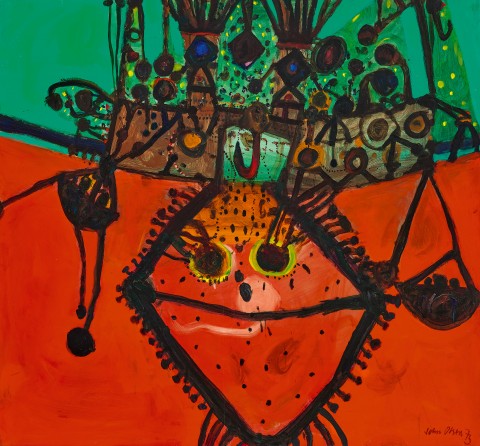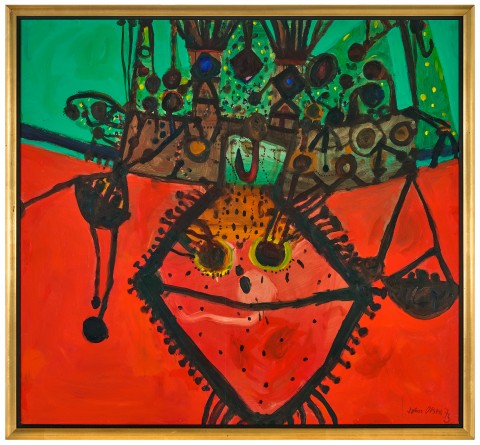NEWCASTLE COAL BOAT, 1973
JOHN OLSEN
oil on composition board
136.0 x 147.0 cm
signed and dated lower right: John Olsen 73
Rudy Komon Art Gallery, Sydney, 1973
Australian Galleries, Melbourne, 1986
Private collection, Melbourne, acquired from the above in 1987
John Olsen: Paintings, Tapestries, Drawings and Lithographs related to his Opera House Mural, Rudy Komon Art Gallery, Sydney, 20 October – 7 November 1973, cat. 4
John Olsen, Atelier 72 Gallery, Adelaide, 11 – 30 March 1974 (on loan from Rudy Komon Gallery)
21st Anniversary Exhibition, Rudy Komon Art Gallery, Sydney, 6 December 1980 – 4 January 1981, cat. 23
John Olsen – In search of the open country 1961 – 1986, Heide Park and Art Gallery, Melbourne, 5 August – 14 September 1986, cat. 6
John Olsen, Australian Galleries, Melbourne, 17 September – 7 October 1986, cat. 10 (illus. in exhibition catalogue)
John Olsen Retrospective, National Gallery of Victoria, Melbourne, Victoria, 1 November 1991 – 3 February 1992; Art Gallery of New South Wales, Sydney, 8 May – 28 June 1992
Millar, R., 'Beaut County', Herald, Melbourne, 15 August 1986, p. 7 (illus.)
Hurlston, D., and Edwards, D., (eds.), John Olsen: The You Beaut Country, National Gallery of Victoria, Melbourne, 2016, p. 147 (illus.)
Hart, D., John Olsen, 2nd ed., Craftsman House, Sydney, 2000, pl. 75, pp. 3, 119, 121 (illus.), 253
We are grateful to Kylie Norton, Editor, John Olsen Catalogue Raisonné, for her assistance with this catalogue entry.
John Olsen was born in Cooks Hill, a suburb of Newcastle, and lived there until he was seven. These were the harsh Depression years when Newcastle was dominated by the BHP steelworks and associated pollutant industries such as mining. Coal was extracted from the banks of the Hunter River (known as Coquun, or Coquon by the traditional custodians, the Awabakal and Worimi people) before being freighted to the port for loading onto ships. In spite of such industrial conditions, Olsen remained a proud Novocastrian throughout his long life and fittingly, his childhood home is located a short walk from the Newcastle Art Gallery which now owns more than forty examples of his work. In 2017, he celebrated his 89th birthday there during the exhibition John Olsen: The City's Son, which included the major painting King Sun and the Hunter, 2016, commissioned by the Newcastle Art Gallery the previous year. However, it is a surprise to discover that Newcastle Coal Boat, 1973 was not painted in the city; rather, it was created in Olsen’s adopted home of Sydney, inspired by the passing steel ships and boats he saw during early morning swims in Camp Cove.
Olsen had returned to Sydney in 1971 after some years living amongst the dry scrub bushlands at Clifton Pugh’s property ‘Dunmoochin’ outside Melbourne. In December that year, the artist-critic James Gleeson invited Olsen to paint a mural at the soon-to-be opened Sydney Opera House. Completed in April 1973, the result was an extraordinary twenty-one metre opus inspired by Kenneth Slessor’s poem Five Bells (1939) – full of the artist’s lively motifs painted over the saturated background pigments, where ‘one can sink into the purpley colour, then float on the light blue, becoming part of the heave of the sea.’1 After the muted earthy tones of the paintings done at Dunmoochin, Olsen’s mastery over such an expanse of colour was a revelation, with him writing in his journal that ‘(c)olour should sing and have the vitality and impact that one colour can have against another. Real colour as opposed to tonal colour – the real colour of Persian miniatures, of the Egyptians.’2 Newcastle Coal Boat continues Olsen’s embrace of these possibilities with its use of an emphatic red-orange for the water and blue-green for the sky. Surmounted by tangled rigging punctuated by spots of yellow light, the ship’s cranes and hooks resemble the predatory menace of a deep-sea angler fish, whilst underwater, the ‘inventive, symmetrical application suggests a face, like a Melanesian mask.’3 It is a deliberately tough painting, though not without Olsen’s trademark humour, for the underwater cables also resemble a gigantic fish looking straight out at the viewer.
When considering the calligraphic marks and squiggles found in paintings such as Newcastle Coal Boat, James Gleeson later wrote of Olsen that ‘[we] are so conscious of the spontaneity that it is often difficult to apprehend the discipline lying behind it. [Olsen] is a master of the art of concealment, of hiding the effort behind an effect of effortlessness, of disguising knowledge as intuition, of painting with a child’s directness and a master’s skill.’4 Originally exhibited at Sydney’s prestigious Rudy Komon Gallery, Newcastle Coal Boat was subsequently retained by the artist for more than a decade, before its re-exhibition at Australian Galleries in Melbourne in 1986. Sold the following year, it has been housed in the same family collection ever since.
1. John Olsen, My salute to Five Bells, National Library of Australia Publishing, Canberra, 2015, p. 20
2. John Olsen, cited in Hart, D., John Olsen, Craftsman House, Sydney, 1991, p. 119
3. Hart, ibid.
4. James Gleeson, ‘Comment’, John Olsen, Judith Wright Centre for Contemporary Arts, Brisbane, 1975, unpaginated
ANDREW GAYNOR


